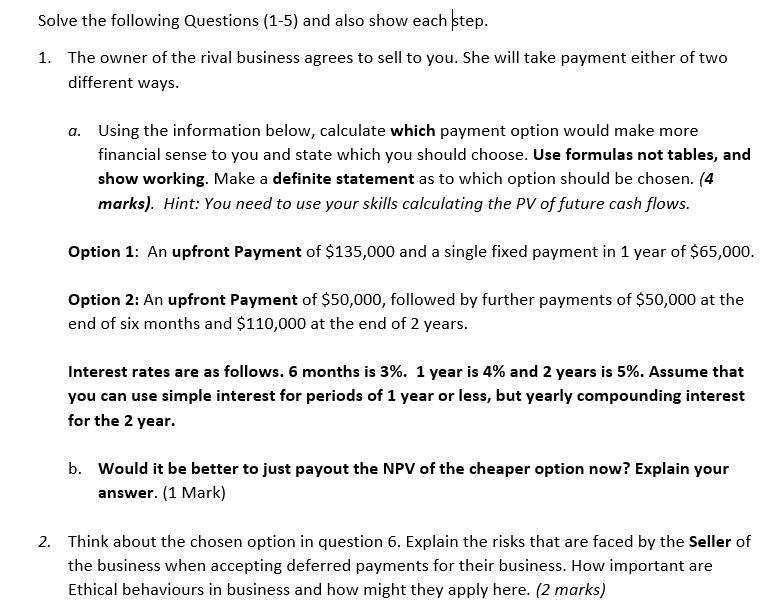

Solve the following Questions (1-5) and also show each step. 1. The owner of the rival business agrees to sell to you. She will take payment either of two different ways. a. Using the information below, calculate which payment option would make more financial sense to you and state which you should choose. Use formulas not tables, and show working. Make a definite statement as to which option should be chosen. (4 marks). Hint: You need to use your skills calculating the PV of future cash flows. Option 1: An upfront Payment of $135,000 and a single fixed payment in 1 year of $65,000. Option 2: An upfront Payment of $50,000, followed by further payments of $50,000 at the end of six months and $110,000 at the end of 2 years. Interest rates are as follows. 6 months is 3%. 1 year is 4% and 2 years is 5%. Assume that you can use simple interest for periods of 1 year or less, but yearly compounding interest for the 2 year. b. Would it be better to just payout the NPV of the cheaper option now? Explain your answer. (1 Mark) 2. Think about the chosen option in question 6. Explain the risks that are faced by the Seller of the business when accepting deferred payments for their business. How important are Ethical behaviours in business and how might they apply here. (2 marks) 3. You just sold your bike for $1,200. You have deposited it into your bank account. You are keen to invest the funds for one year as you are concentrating on your studies for the moment. Which of the following options for depositing the funds will earn you more interest over the coming year? Show your calculations including formula. (2 marks) a. Fixed Interest rate of 6% paid at maturity. b. 5.9% Interest rate compounded and reinvested on a monthly basis. 5.8% Interest rate compounded and reinvested on a daily basis. C. 4. Explain the effect that using compounding interest rates versus simple interest rates has on the return from an investment. (1 mark) 5. a. Name and describe an example of an annuity other than Rent that that is commonly encountered by businesses in the Australian economy. (1 Mark) b. Calculate the Present Value of the following Annuity Payment. $9,000 paid in arrears for 10 years. Assume that the current yield curve shows a 10-year bond rate of 7% p.a. (1 Mark) Tip: Look at Topic 3. Seminar 3 notes explain this and then use the spreadsheet called NPV to check your calculations. Solve the following Questions (1-5) and also show each step. 1. The owner of the rival business agrees to sell to you. She will take payment either of two different ways. a. Using the information below, calculate which payment option would make more financial sense to you and state which you should choose. Use formulas not tables, and show working. Make a definite statement as to which option should be chosen. (4 marks). Hint: You need to use your skills calculating the PV of future cash flows. Option 1: An upfront Payment of $135,000 and a single fixed payment in 1 year of $65,000. Option 2: An upfront Payment of $50,000, followed by further payments of $50,000 at the end of six months and $110,000 at the end of 2 years. Interest rates are as follows. 6 months is 3%. 1 year is 4% and 2 years is 5%. Assume that you can use simple interest for periods of 1 year or less, but yearly compounding interest for the 2 year. b. Would it be better to just payout the NPV of the cheaper option now? Explain your answer. (1 Mark) 2. Think about the chosen option in question 6. Explain the risks that are faced by the Seller of the business when accepting deferred payments for their business. How important are Ethical behaviours in business and how might they apply here. (2 marks) 3. You just sold your bike for $1,200. You have deposited it into your bank account. You are keen to invest the funds for one year as you are concentrating on your studies for the moment. Which of the following options for depositing the funds will earn you more interest over the coming year? Show your calculations including formula. (2 marks) a. Fixed Interest rate of 6% paid at maturity. b. 5.9% Interest rate compounded and reinvested on a monthly basis. 5.8% Interest rate compounded and reinvested on a daily basis. C. 4. Explain the effect that using compounding interest rates versus simple interest rates has on the return from an investment. (1 mark) 5. a. Name and describe an example of an annuity other than Rent that that is commonly encountered by businesses in the Australian economy. (1 Mark) b. Calculate the Present Value of the following Annuity Payment. $9,000 paid in arrears for 10 years. Assume that the current yield curve shows a 10-year bond rate of 7% p.a. (1 Mark) Tip: Look at Topic 3. Seminar 3 notes explain this and then use the spreadsheet called NPV to check your calculations








